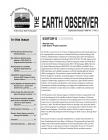The Earth Observer has a new look! Visit the NEW Earth Observer website.
The Earth Observer: Sep - Oct, 1999
In This Issue
Click title below to view page
- Editor's CornerFront Cover
- In This Issue
- EOS PM Science Working Group Meeting Minutes3
- May 1999 User Working Group Meeting—ORNL DAAC for Biogeochemical Dynamics8
- Requirements For Landslide Signature Observation By Satellite11
- USRA/GSFC Graduate Student Summer 2000 Program In Earth System Science13
- Annual Depletion Of Antarctic Ozone Results Are In: ‘Ozone Hole’ Smaller Than Last Year14
- NASA Unveils New, Most Accurate Map Of Antarctic Continent15
- Earth Science Education Update: Opportunity To Participate In Digital Library For Earth Science Education16
- EOS Scientists in the News17
- Student, School Receive Award for Naming EOS Satellite18
- Calendars19
- Information/InquiriesBack cover
Editor's Corner
Michael King, EOS Senior Project Scientist
On October 14 and 15, the U.S. House of Representatives and Senate approved the Appropriations Conference Committee bill that provides funding to the Veterans Administration, Department of Housing and Urban Development, and Independent Agencies (including NASA) for FY00. This bill, approved by President Clinton on October 20, provides funding for NASA of $13.653 B, of which the Earth Science Enterprise is $1.455 B. Of this budget, $663.2 M is for the Earth Observing System (EOS), $231.5 M for EOSDIS, and $420.2 M for applied research and data analysis, including the research & analysis program, EOS calibration and validation program, and EOS Interdisciplinary Science (IDS) investigations. The conference report includes $36.3 M of the Earth Science budget for earmarks, including support of research centers at eight universities for natural resource training and remote-sensing applications; support of biodiversity programs at two museums; a space-based research initiative for the study and detection of forest fires; funding for continued development of battery technology; and support for additional uses of the EOSDIS Core System to make data more readily available for potential user communities.
The bill preserves the Triana program, but directs NASA to suspend all work on the development of the satellite until the National Academy of Sciences (NAS) has completed an evaluation...
Read more...

